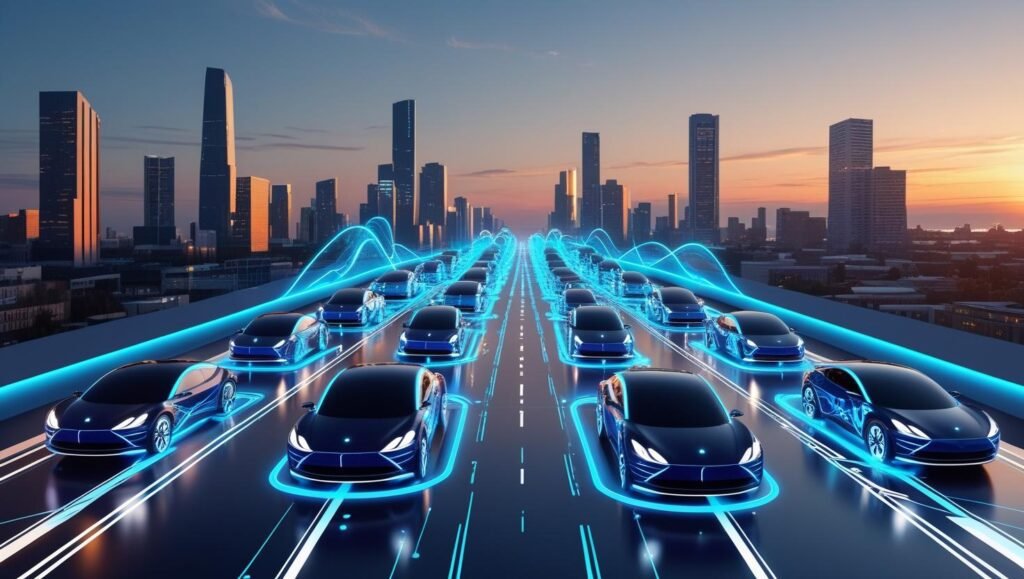Low Latency in 5G IoT Drives Reliable Autonomous Vehicle Tech

Imagine a world where cars drive themselves safely, reacting instantly to traffic, pedestrians, or road changes. This isn’t sci-fi—it’s happening now, thanks to low latency in 5G IoT technology. Low latency means super-fast communication with almost no delay, and it’s the key to making autonomous vehicles reliable. In this blog, we’ll explore how low latency in 5G IoT powers self-driving cars, why it matters, and what challenges we face. But we’ll leave some exciting details for you to discover in our full research paper!
What Is Low Latency and Why Does It Matter?
Low latency refers to the tiny amount of time it takes for data to travel from one point to another. In 5G IoT systems, this delay is often just a few milliseconds. For autonomous vehicles, this speed is a game-changer. Self-driving cars need to process tons of data—like sensor readings, GPS signals, and traffic updates—right away to make split-second decisions.
Why is low latency so important? A delay of even a second could mean the difference between stopping for a pedestrian or causing an accident. With 5G’s ultra-fast speeds, cars can “talk” to each other and to smart traffic systems instantly, keeping roads safer.
How 5G Enables Low Latency for IoT in Autonomous Vehicles
5G networks are built to handle massive amounts of data with incredible speed. Unlike older networks like 4G, 5G offers low latency through advanced technology. Let’s break it down:
- Network Slicing: 5G creates dedicated “lanes” for different types of data. Autonomous vehicles get a fast lane for critical signals, ensuring low latency.
- Edge Computing: Data is processed closer to the car, not in faraway servers. This cuts down travel time for information, boosting low latency.
- Massive Connectivity: 5G supports millions of IoT devices at once, so cars, traffic lights, and sensors can all communicate without delays.
These features make 5G perfect for self-driving cars, which rely on IoT devices like cameras, radar, and sensors to navigate roads safely.
Real-Time Decision Making in Self-Driving Cars
Autonomous vehicles depend on low latency to react in real time. For example, if a child runs into the street, the car’s sensors detect it, send data to the system, and decide to brake—all in milliseconds. Low latency in 5G IoT ensures this process is seamless. Without it, even a slight delay could lead to dangerous outcomes.
This speed also helps cars communicate with each other. If one car slows down suddenly, it can instantly alert nearby vehicles, preventing pile-ups. This kind of vehicle-to-vehicle (V2V) communication is only possible with 5G’s low latency.
Benefits of Low Latency in 5G IoT for Autonomous Vehicles
Low latency doesn’t just make self-driving cars faster—it makes them better in many ways. Here are some key benefits:
- Safer Roads: Quick data processing helps cars avoid obstacles and react to changes instantly.
- Smoother Traffic: Cars can coordinate with traffic systems to reduce congestion and optimize routes.
- Better Passenger Experience: Low latency ensures navigation and entertainment systems run without lag, making rides more enjoyable.
- Reliable Performance: Even in crowded cities with many IoT devices, 5G keeps communication fast and stable.
These advantages show why low latency is critical for the future of autonomous driving. But there’s more to explore about how these systems work together—details you’ll find in our research paper.

Challenges of Achieving Low Latency in 5G IoT
While low latency in 5G IoT is exciting, it’s not without challenges. Building a reliable system for autonomous vehicles takes a lot of work. Here are some hurdles:
- Network Coverage: 5G needs strong coverage everywhere, but rural areas often lack it.
- Interference: Crowded cities with many devices can cause signal disruptions, affecting low latency.
- Cost: Setting up 5G infrastructure, like towers and edge servers, is expensive.
- Security: Fast data transfer must be secure to prevent hacking of self-driving cars.
Solving these issues is crucial to making low latency work for autonomous vehicles. Curious about how experts are tackling these problems? Our research paper dives deeper into solutions and future trends.
The Future of Low Latency in Autonomous Vehicles
Low latency in 5G IoT is paving the way for a future where self-driving cars are everywhere. Imagine cities where traffic flows smoothly, accidents are rare, and cars drive themselves with perfect precision. This technology could also extend beyond cars to drones, delivery robots, and smart traffic systems, all working together seamlessly.
But there’s still so much to learn about how 5G and IoT will shape this future. From technical breakthroughs to real-world testing, the full story of low latency’s impact is unfolding. Want to know more about what’s next? Check out our research paper for the latest insights!
Conclusion
Low latency in 5G IoT is transforming autonomous vehicles, making them safer, smarter, and more reliable. By enabling real-time communication, 5G helps self-driving cars react instantly to their surroundings, paving the way for a future with fewer accidents and smoother traffic. While challenges like coverage and security remain, the potential is huge. To dive deeper into how low latency is revolutionizing IoT and autonomous tech, read our full research paper. It’s packed with details you won’t want to miss!
[Read the Full Research Paper]




